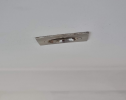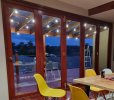Hi,
My family and I moved into a rental property about 7 weeks ago and there have been nothing but issues since. The main one, a leaking shower in our ensuite which caused significant water damage to the ceiling and then to the carpet of one of our children's bedrooms below, meant we were without the use of either the bathroom or bedroom for 6 weeks (they have now - eventually, after a lot of false starts and delays that were caused by the landlord taking shortcuts and hiring shoddy tradespeople who were unqualified and likely family friends rather than professionals - been repaired, although to a poor standard).
There are still a number of outstanding issues with the property and I was hoping to get some advice about where we stand as tenants in demanding that they be resolved properly.
1. When the leak occurred in the bedroom ceiling, the water dripped through the plaster and all over the carpet of the my 3 year old daughter's bedroom. We didn't know about it for a number of hours as we weren't using the bedroom at the time, and by the time we knew about it, there was a big (approximately 1.5x1.5 metre) soaking wet patch in the carpet in the centre of the room. We reported the issue immediately but the landlord (via the agency) never really addressed the water damage to the carpet. It sat there with a wet patch for quite some time, at least a week but we're not even sure when it finally dried as we effectively stopped using the room and waited for the repairs to be completed. The landlord has said they are not prepared do anything about the carpet other than to offer a clean, despite my understanding that carpets left wet for more than a couple of days is at major risk of mould developing in the underlay which, once formed, is very difficult to remove and certainly not just with a regular clean. I have a UV flashlight, and I've shined it on the carpet where it was wet and there is a very obvious patch visible in UV light. I'm concerned that it's evidence of mould although in normal light I can't see anything. I understand that given the water dripped through the plasterboard, it could be gypsum residue (which I believe glows blue under UV light), but it's hard to be certain.
See below:

2. The ceiling, which was sagging considerably due to the water damage, was 'fixed', but only a roughly 2m x 1.5m section was cut out and repaired, instead of the whole ceiling. The overall ceiling sagging was left untouched, so although the rotten plasterboard was replaced, the ceiling still has a pronounced sag towards the middle. It's particularly obvious because the maximum angle of sag coincides with the downlights, which I measured was at a 5.8 degree angle off horizontal. See this image (the lines in the background are horizontal cornices):

Again, the landlord has not agreed to do anything to address the sag. Yes, it's likely just cosmetic, but are tenants entitled to ceilings that are actually horizontal and not sagging due to previous water damage?
3. We have an open plan living room/dining room area which leads to a large covered deck area to provide an 'indoor/outdoor' space. The left side has a normal door and then next to the door, a series of concertina doors that span the rest of the deck width. Ever since we moved in, the concertina doors have been completely jammed shut. The door to the deck was also 'sticky' and the agency arranged a handyman to come and shave a bit off the door to allow it to open and close properly. The handyman said that he thinks the support beam that spans the width above the doors may be sagging and that is what could have caused both the normal door to stick and the concertina doors to jam, as it is effectively holding the load of a large portion of the house. He suggested an engineer may have to look at the plans and determine whether the beam is in fact capable of supporting that load. To get a sense of the doors, see below. Left area is the regular door (that we can open), the next 4 sections are the jammed concertina doors:

We've been waiting weeks for this issue to be addressed further, and have finally got a response from the landlord that they are not prepared to fix the concertina doors as the door to the left works. We feel that this is not really the point, as the concertina doors are a FEATURE of the house, not merely a way of exiting to the deck. It'd be nice (when the weather improves) to be able to have the concertina doors wide open and be able to walk in and out and use it as it was intended. It was one of the main features of the house that attracted to us in the first place. Is the landlord entitled to say "sorry, not going to fix it, you can use the door instead"? I'm unsure where the boundary lies in terms of what a tenant is entitled to expect for repairs. Tenants Victoria suggests tenants should expect a landlord to arrange all repairs, it doesn't say whether there are exceptions where a landlord can simply say "no".
We're looking like we're heading for VCAT, not just for the outstanding issues themselves to be addressed, but for the compensation for the quite significant inconvenience that we've been through over the last 6 weeks. Any thoughts/advice?
My family and I moved into a rental property about 7 weeks ago and there have been nothing but issues since. The main one, a leaking shower in our ensuite which caused significant water damage to the ceiling and then to the carpet of one of our children's bedrooms below, meant we were without the use of either the bathroom or bedroom for 6 weeks (they have now - eventually, after a lot of false starts and delays that were caused by the landlord taking shortcuts and hiring shoddy tradespeople who were unqualified and likely family friends rather than professionals - been repaired, although to a poor standard).
There are still a number of outstanding issues with the property and I was hoping to get some advice about where we stand as tenants in demanding that they be resolved properly.
1. When the leak occurred in the bedroom ceiling, the water dripped through the plaster and all over the carpet of the my 3 year old daughter's bedroom. We didn't know about it for a number of hours as we weren't using the bedroom at the time, and by the time we knew about it, there was a big (approximately 1.5x1.5 metre) soaking wet patch in the carpet in the centre of the room. We reported the issue immediately but the landlord (via the agency) never really addressed the water damage to the carpet. It sat there with a wet patch for quite some time, at least a week but we're not even sure when it finally dried as we effectively stopped using the room and waited for the repairs to be completed. The landlord has said they are not prepared do anything about the carpet other than to offer a clean, despite my understanding that carpets left wet for more than a couple of days is at major risk of mould developing in the underlay which, once formed, is very difficult to remove and certainly not just with a regular clean. I have a UV flashlight, and I've shined it on the carpet where it was wet and there is a very obvious patch visible in UV light. I'm concerned that it's evidence of mould although in normal light I can't see anything. I understand that given the water dripped through the plasterboard, it could be gypsum residue (which I believe glows blue under UV light), but it's hard to be certain.
See below:

2. The ceiling, which was sagging considerably due to the water damage, was 'fixed', but only a roughly 2m x 1.5m section was cut out and repaired, instead of the whole ceiling. The overall ceiling sagging was left untouched, so although the rotten plasterboard was replaced, the ceiling still has a pronounced sag towards the middle. It's particularly obvious because the maximum angle of sag coincides with the downlights, which I measured was at a 5.8 degree angle off horizontal. See this image (the lines in the background are horizontal cornices):

Again, the landlord has not agreed to do anything to address the sag. Yes, it's likely just cosmetic, but are tenants entitled to ceilings that are actually horizontal and not sagging due to previous water damage?
3. We have an open plan living room/dining room area which leads to a large covered deck area to provide an 'indoor/outdoor' space. The left side has a normal door and then next to the door, a series of concertina doors that span the rest of the deck width. Ever since we moved in, the concertina doors have been completely jammed shut. The door to the deck was also 'sticky' and the agency arranged a handyman to come and shave a bit off the door to allow it to open and close properly. The handyman said that he thinks the support beam that spans the width above the doors may be sagging and that is what could have caused both the normal door to stick and the concertina doors to jam, as it is effectively holding the load of a large portion of the house. He suggested an engineer may have to look at the plans and determine whether the beam is in fact capable of supporting that load. To get a sense of the doors, see below. Left area is the regular door (that we can open), the next 4 sections are the jammed concertina doors:

We've been waiting weeks for this issue to be addressed further, and have finally got a response from the landlord that they are not prepared to fix the concertina doors as the door to the left works. We feel that this is not really the point, as the concertina doors are a FEATURE of the house, not merely a way of exiting to the deck. It'd be nice (when the weather improves) to be able to have the concertina doors wide open and be able to walk in and out and use it as it was intended. It was one of the main features of the house that attracted to us in the first place. Is the landlord entitled to say "sorry, not going to fix it, you can use the door instead"? I'm unsure where the boundary lies in terms of what a tenant is entitled to expect for repairs. Tenants Victoria suggests tenants should expect a landlord to arrange all repairs, it doesn't say whether there are exceptions where a landlord can simply say "no".
We're looking like we're heading for VCAT, not just for the outstanding issues themselves to be addressed, but for the compensation for the quite significant inconvenience that we've been through over the last 6 weeks. Any thoughts/advice?
Last edited: